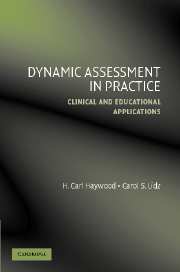Book contents
- Frontmatter
- Contents
- Preface
- Foreword, by Kenneth A. Dodge
- Foreword, by Thomas Oakland
- PART ONE THEORY AND PRINCIPLES
- PART TWO APPLICATIONS
- APPENDIX A TESTS REFERRED TO IN THE TEXT THAT DO NOT BELONG TO THE AUTHORS
- APPENDIX B SOURCES OF DYNAMIC ASSESSMENT MATERIALS
- References
- Author Index
- Subject Index
- Tests and Testing Materials Index
Foreword, by Kenneth A. Dodge
Published online by Cambridge University Press: 04 December 2009
- Frontmatter
- Contents
- Preface
- Foreword, by Kenneth A. Dodge
- Foreword, by Thomas Oakland
- PART ONE THEORY AND PRINCIPLES
- PART TWO APPLICATIONS
- APPENDIX A TESTS REFERRED TO IN THE TEXT THAT DO NOT BELONG TO THE AUTHORS
- APPENDIX B SOURCES OF DYNAMIC ASSESSMENT MATERIALS
- References
- Author Index
- Subject Index
- Tests and Testing Materials Index
Summary
This text bucks a trend in clinical psychology. Much of modern-day assessment in the field has sadly become the formulaic application of computerized rules that unabashedly serve the singular goal of satisfying health insurers' mindless requirements for a psychiatric diagnosis. The practice of assessment has become restricted by those requirements. Technicians, or – even more frequently – computer programs, transform a client's responses to multiple-choice questions into numbers and categories that allow a clinical psychologist to begin intervention. In the best case, the intervention is “evidence-based” and grounded in empirical evaluation. But the divide between assessment and intervention has grown deeper, and the client's well-being has suffered.
Haywood and Lidz provide a much-needed antidote to this trend. They carry the torch of the rich tradition of transactional psychology and dynamic assessment in this novel text that brings these principles to life. This is a dynamic application of dynamic assessment.
The critical principle is that there is no divide between assessment and intervention. Intervention is assessment, and assessment is the intervention. The clinician learns about the client by testing the client's skill, knowledge, and ability to learn. The clinician asks a question, the client demonstrates, and the clinician aligns that response with an intricately structured, multi-dimensional schema and then asks another question. It is the relationship between clinician and client that is transactional, dynamic, and growing. The interaction is simultaneously an assessment of the client's current level of functioning and an intervention to boost that level.
- Type
- Chapter
- Information
- Dynamic Assessment in PracticeClinical and Educational Applications, pp. xiii - xviPublisher: Cambridge University PressPrint publication year: 2006



